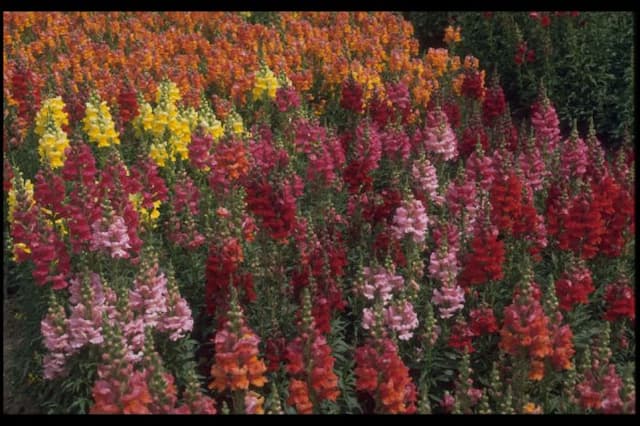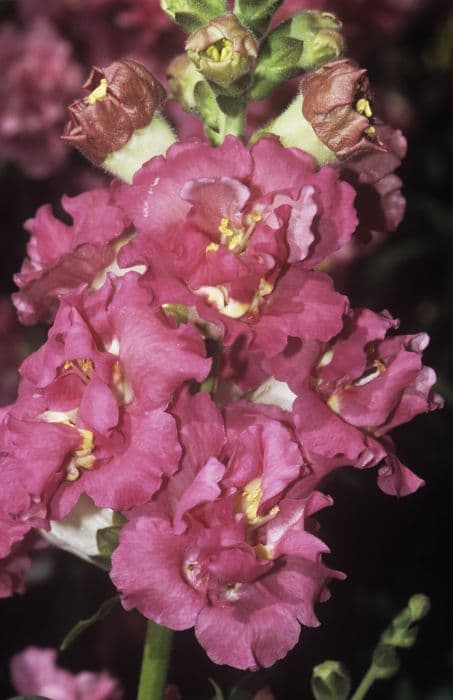Hebe Blue Haze Hebe Blue Haze = 'Lowchi' (PBR) (Garden Beauty Series)

ABOUT
The Hebe Blue Haze, part of the Garden Beauty Series, has an attractive and dense foliage that presents itself in a lush, rounded form. Its leaves possess a striking silver-green color with an almost glaucous, or frosted, appearance that adds to its unique visual appeal. During the blooming period, the plant produces a bounty of flowers arranged in spiked inflorescences. These blooms are a soft lavender-blue, creating a serene and cool-toned display that contrasts beautifully with the silver-green foliage, giving the plant its 'Blue Haze' distinction. The overall presentation of the Hebe Blue Haze is one of neatness and ornamental charm, making it a popular choice for gardeners seeking to add a touch of cool elegance to their garden palette.
About this plant
 Names
NamesSynonyms
Hebe 'Lowchi', Garden Beauty Blue Haze.
Common names
Hebe 'Lowchi' (PBR) (Garden Beauty Series).
 Toxicity
ToxicityTo humans
Hebe 'Blue Haze' is not widely known for toxicity to humans, and there is limited information suggesting it is hazardous. However, as with any plant not typically used for consumption, it is good practice to avoid ingestion. If ingested, it could potentially cause stomach upset or an allergic reaction in some individuals. It is always advisable to keep plants that are not meant for consumption out of the reach of children to prevent any accidental ingestion.
To pets
Hebe 'Blue Haze' is not commonly listed as toxic to pets, such as cats and dogs. However, pets can have unexpected reactions to consuming non-food plants, which could include vomiting, diarrhea, or salivation. If a pet ingests part of this plant and shows adverse symptoms, it is recommended to consult with a veterinarian. Generally, to ensure safety, keep the plant away from pets to avoid any potential risks.
 Characteristics
CharacteristicsLife cycle
Perennials
Foliage type
Evergreen
Color of leaves
Green
Flower color
Blue
Height
2 feet (60 cm)
Spread
2 feet (60 cm)
Plant type
Shrub
Hardiness zones
8
Native area
New Zealand
Benefits
 General Benefits
General Benefits- Attractive foliage: Hebe 'Blue Haze' offers silver-blue evergreen leaves that provide year-round color and texture to the garden.
- Long flowering period: This cultivar has a lengthy bloom time, with flowers peaking in summer and adding interest throughout multiple seasons.
- Drought tolerance: Once established, 'Blue Haze' is relatively drought-tolerant, which is beneficial in dry climates or for water-wise gardens.
- Low maintenance: Requires minimal care beyond occasional pruning to maintain its compact shape and encourage bushiness.
- Attracts pollinators: The flowers of Hebe 'Blue Haze' provide nectar for bees and butterflies, supporting local biodiversity.
- Compact size: This plant remains small and neat, making it ideal for use in borders, containers, or small spaces in the garden.
- Hardiness: Exhibits good resistance to cold temperatures and can survive in a range of climates with proper care.
- Versatility: Suitable for various garden styles, including formal, cottage, or contemporary designs.
 Medical Properties
Medical PropertiesThis plant is not used for medical purposes.
 Air-purifying Qualities
Air-purifying QualitiesThis plant is not specifically known for air purifying qualities.
 Other Uses
Other Uses- Artistic inspiration: The dense foliage and vibrant hues of Hebe Blue Haze make it an excellent subject for botanical illustration and garden photography, offering a unique aesthetic appeal for artists and photographers.
- Crafting natural dyes: The leaves and flowers of Hebe Blue Haze could potentially be used to create natural dyes for fabrics or artwork, although specific recipes would need to be developed through experimentation.
- Garden theming: Hebe Blue Haze can be used in thematic garden designs, such as blue and purple color-themed gardens or coastal garden styles that reflect its origin and natural habitat.
- Educational tool: Horticulture teachers and educators can use Hebe Blue Haze to teach principles of plant care, propagation, and garden design, given its distinct characteristics and growth requirements.
- Culinary decoration: While not traditionally used for culinary purposes, the flowers of Hebe Blue Haze could be used as an edible decoration for desserts or drinks, if confirmed safe for consumption.
- Bee and butterfly habitat: Planting Hebe Blue Haze in gardens can provide a nectar source for bees and butterflies, contributing to the conservation of these important pollinators.
- Floral arrangements: The long-lasting flowers of Hebe Blue Haze can be used in cut floral arrangements to bring a touch of the garden indoors.
- Garden sculpture: The compact and dense habit of Hebe Blue Haze can be shaped into interesting topiary forms, offering an opportunity for creative garden sculptures.
- Landscape photography: Its striking blue-purple flowers and structured form can serve as a focal point in landscape photography, especially when it blooms against contrasting foliage or during golden hour lighting.
- Children’s garden projects: Hebe Blue Haze is suitable for children's gardening activities, where they can learn about plant life cycles and create their own mini gardens or terrariums using this plant.
Interesting Facts
 Feng Shui
Feng ShuiThe Hebe plant is not used in Feng Shui practice.
 Zodiac Sign Compitability
Zodiac Sign CompitabilityThe Hebe plant is not used in astrology practice.
 Plant Symbolism
Plant Symbolism- Everlasting love: Hebe is often associated with eternal and undying affection, stemming from its evergreen nature and its namesake, the Greek goddess of youth.
- Youthfulness: Named after Hebe, the goddess of youth in Greek mythology, this plant symbolizes maintaining a youthful spirit and energy.
- Vitality: The robust nature of the Hebe plant, along with its vibrant flowers, represents good health and vigor.
- Protection: In some traditions, Hebe plants are thought to offer protection due to their hardy character and ability to thrive in various conditions.
 Water
WaterHebe 'Blue Haze' prefers consistent moisture but does not like to be oversaturated. Water the plant deeply once or twice a week, depending on the weather conditions, allowing the soil to dry out slightly between waterings. During hot, dry spells, you may need to water the plant more frequently. Aim to provide the equivalent of about 1-2 gallons of water per week during the growing season. During winter, reduce watering as the plant's growth slows down and it requires less moisture.
 Light
LightHebe 'Blue Haze' thrives in full sun to partial shade conditions. The best spot for this plant would be in an area where it receives at least six hours of sunlight each day. If grown indoors, place it near a south-facing window to ensure it gets enough light.
 Temperature
TemperatureHebe 'Blue Haze' can tolerate a range of temperatures, but performs best when the temperature is between 50°F and 70°F. It can survive minimum temperatures of around 30°F but should be protected from frost. Ideal growing conditions would prevent exposure to temperatures exceeding 80°F for extended periods.
 Pruning
PruningPrune Hebe 'Blue Haze' to maintain shape and encourage bushier growth, usually in late winter or early spring before new growth begins. Cut back up to one-third of the old growth to keep the plant looking tidy. Pruning can also be done after the plant has finished blooming to remove spent flower stems.
 Cleaning
CleaningAs needed
 Soil
SoilThe Hebe Blue Haze prefers well-draining soil with a mixture of loam, peat, and sharp sand, ensuring good aeration and moisture retention. The ideal pH range for this plant is slightly acidic to neutral, between 6.0 and 7.0.
 Repotting
RepottingThe Hebe Blue Haze should be repotted every 2 to 3 years to refresh the soil and accommodate root growth. Spring is the best time for repotting to minimize stress on the plant.
 Humidity & Misting
Humidity & MistingHebe Blue Haze thrives in moderate humidity conditions. Aiming for a humidity level around 40-50% would be ideal for this plant, avoiding excessively dry or overly humid environments.
 Suitable locations
Suitable locationsIndoor
Place in bright, indirect light and ensure proper drainage.
Outdoor
Plant in partial sun, shelter from harsh winds.
Hardiness zone
7-10 USDA
 Life cycle
Life cycleThe Hebe Blue Haze, a hardy perennial shrub, begins its life cycle from a seed or cutting, with germination typically occurring in a controlled nursery environment. Following germination, the plant enters a period of vegetative growth, developing a fibrous root system and producing stems, leaves, and its characteristic blue-purple flowers during the growing season. After the flowering phase, which usually takes place in late spring to early summer, pollination may occur, leading to seed formation if compatible pollen is present. Throughout its life, the Hebe Blue Haze will undergo cycles of growth and dormancy, typically with dormant periods during colder months. With proper care, the plant can live for several years, continuing to grow and flower annually. Eventually, as it reaches the end of its lifespan, growth will slow and the plant will die back, but it may have propagated itself through seeds or cuttings if conditions allowed.
 Propogation
PropogationPropogation time
Spring-Early Summer
Propogation: Hebe 'Blue Haze' is commonly propagated by semi-hardwood cuttings. This method typically involves taking cuttings from the current year's growth during late summer to early autumn. Select healthy, non-flowering shoots and cut a 3 to 5 inch (7.5 to 12.5 centimeters) section making sure that it includes several leaf nodes. The cut end of the shoot can be dipped in rooting hormone powder to encourage root growth. Then plant the cutting in a well-draining potting mix, ensuring that a couple of leaf nodes are buried in the soil where roots can form. The pot should be placed in a warm, brightly lit area out of direct sunlight and kept consistently moist. Rooting can take several weeks, after which the new Hebe plant can be gradually acclimatized to outside conditions before being planted out in the garden.





![Snapdragon [Pretty in Pink]](/_next/image?url=https%3A%2F%2Fplants-admin.emdemapps.com%2Fimages%2Fplants%2F%2Fimages%2F604b5cb3b5385.png&w=640&q=75)



